Freesia flowers are cherished for their vibrant hues and sweet, citrus-like fragrance, making them a favorite among gardeners and florists alike. Native to South Africa, these delicate blooms belong to the Iridaceae family and are named after the German botanist Friedrich Freese.
Freesia flowers are funnel-shaped and grow in clusters along one side of a graceful, arching stem. They come in a spectrum of colors, including white, yellow, pink, red, purple, and blue. Freesias typically bloom in late winter to early spring. However, with the right care, they can be coaxed into blooming at various times of the year, providing a colorful display during different seasons. The leaves are narrow, sword-shaped, and arranged in a fan-like pattern, providing a lush green backdrop to the vibrant flowers.
One of the standout features of freesia flowers is their delightful fragrance, often described as a blend of fresh, fruity, and floral notes. This makes them highly valued in the perfume industry and as cut flowers for bouquets and arrangements.
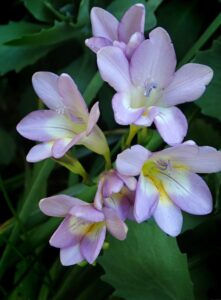
Sunlight Requirement
Freesias flourish in full sun but can also tolerate partial shade. Ideally, they should receive at least 6 hours of direct sunlight daily. If you live in a hotter climate, providing freesia flowers with morning sunlight and some afternoon shade can help protect them from the intense midday heat.
For indoor growing, place freesias in a spot where they can get bright, indirect light. A south-facing window is often ideal, but ensure they are not exposed to direct sunlight through the glass for prolonged periods.
Temperature and Humidity requirement of Freesia Flowers
Freesias prefer daytime temperatures between 60°F to 70°F (15°C to 21°C). They thrive with cooler nighttime temperatures around 50°F to 55°F (10°C to 13°C). Freesias can tolerate slightly higher temperatures but prolonged exposure to temperatures above 75°F (24°C) can hinder flowering. They are sensitive to frost, so protect them from temperatures below 32°F (0°C).
In warmer climates, it might be beneficial to plant freesias in the fall for spring blooms, while in cooler climates, planting in the spring is ideal.
Freesias prefer moderate humidity levels. Extremely high humidity can promote fungal diseases, while very low humidity can cause the flowers and buds to dry out.
Soil Requirement
Freesias require soil that drains well to prevent waterlogging, which can lead to root rot. Sandy loam or loamy soil is ideal as it provides good drainage while retaining enough moisture for the roots. Freesias prefer slightly acidic to neutral soil with a pH range of 6.0 to 7.0.
Freesias benefit from soil that is rich in nutrients. Adding a balanced, slow-release fertilizer at planting time can provide essential nutrients. Supplementing with a liquid fertilizer during the growing season can also help support their growth and flowering.
If your garden soil is heavy clay or poorly draining, consider planting freesias in raised beds or containers with well-draining potting mix. This can provide better control over soil conditions.

Propagation of Freesia Flowers
Propagating freesia flowers can be done through corms (bulb-like structures) and seeds. Here’s a detailed guide on how to propagate freesias using both methods:
Propagation from Corms
Choose healthy, firm corms free from mold or damage. Larger corms tend to produce more robust plants and better blooms.
Plant corms in the fall for spring blooms in milder climates or in late winter/early spring in colder regions.
Plant the corms about 2 inches (5 cm) deep with the pointed end facing up.
Space them approximately 3 inches (7.5 cm) apart.
Ensure the soil is well-draining and enriched with organic matter.
Water the soil thoroughly after planting.
Water regularly to keep the soil moist but not waterlogged.
Apply a balanced fertilizer every few weeks during the growing season.
Corms Division
After the flowering season, when the foliage has died back, you can dig up the corms.
Separate the new corms (cormlets) from the parent corms.
Store the corms in a cool, dry place until the next planting season.
Propagation from Seeds
Collect seeds from mature freesia plants after the flowers have faded and seed pods have dried.
Soak the seeds in warm water for 24 hours before planting to enhance germination.
Fill seed trays or pots with a well-draining seed starting mix.
Sow the seeds on the surface and lightly cover them with a thin layer of soil.
Place the trays or pots in a warm, bright location with indirect sunlight.
Maintain a consistent temperature around 60°F to 70°F (15°C to 21°C).
Keep the soil consistently moist but not waterlogged.
Once the seedlings have developed several leaves and are strong enough to handle, transplant them into individual pots or directly into the garden.
Be patient, as freesia plants grown from seeds may take a year or more to bloom.
Provide regular care, including watering, feeding, and ensuring proper sunlight exposure.
By following these steps, you can successfully propagate freesia flowers through corms and seeds, ensuring a beautiful display of blooms in your garden.
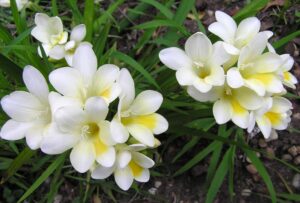
Watering Requirements of Freesia Flowers
Freesias need consistent moisture, especially during their active growing period. The soil should be kept evenly moist but not waterlogged. Water the plants thoroughly whenever the top inch of soil feels dry.
After the flowering period, reduce watering as the plant enters dormancy. Allow the foliage to die back naturally.
Fertilizer Requirements
Freesia flowers benefit from a balanced and thoughtful fertilization regimen to support their growth and blooming. Incorporate compost or well-rotted manure into the soil before planting. This enriches the soil with organic matter and essential nutrients. Use a balanced, all-purpose fertilizer, such as 10-10-10 (N-P-K) or 5-10-10.
Application Timings: Mix a slow-release granular fertilizer into the soil at the time of planting the corms. Apply a balanced liquid fertilizer every 2-4 weeks during the active growing season, from when the shoots first appear until the flowers start to bloom. After the flowers have faded, continue to feed the plants with a balanced fertilizer for a few weeks to help the corms store energy for the next growing season.
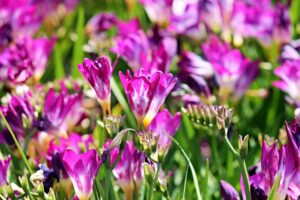
Problems While Growing Freesia Flowers
Growing freesia flowers can be rewarding, but gardeners may encounter several common problems. Here are the issues you might face and how to address them:
Poor Germination or Growth
Improper planting depth, inadequate soil conditions, or insufficient watering. So, Ensure corms are planted about 2 inches deep and 3 inches apart in well-draining, nutrient-rich soil. Maintain consistent soil moisture without overwatering.
Fungal Diseases
Botrytis (gray mold), Fusarium wilt, and root rot are common fungal diseases that shows symptoms like Yellowing leaves, wilting, mold on leaves or corms, and stunted growth. To control fungal attack provide good air circulation, avoid overhead watering, and ensure soil drains well. Remove and dispose of infected plant parts. Use fungicides if necessary.
Pests
Common pests that attack on freesia flowers are aphids, thrips, spider mites, and bulb mites that shows discolored or distorted leaves, sticky residue (honeydew), and visible insects on plants. To control use insecticidal soap or neem oil to control pests. Encourage beneficial insects like ladybugs. Regularly inspect plants for signs of infestation.
Corm Rot
Corm rot is caused by overwatering, poor drainage, or fungal infections due to which corms become soft, mushy, and poor sprouting. To control this issue plant corms in well-draining soil and avoid waterlogging. Treat corms with a fungicide before planting if fungal issues are common in your area.
Freesia flowers are prized for their vibrant colors, sweet fragrance, and elegant form, making them highly versatile for various ornamental uses. Here are some popular ways to incorporate freesia flowers into ornamental settings:
Ornamental Uses of Freesia Flowers
Cut Flower Arrangements: Freesias are a favorite in floral arrangements due to their long-lasting blooms and delightful fragrance. They can be used alone in simple bouquets or mixed with other flowers like roses, lilies, and tulips for more complex arrangements.
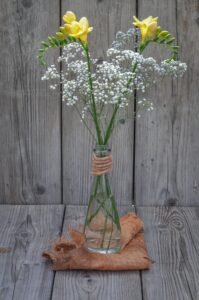
Garden Borders and Edging: Plant freesia corms along garden borders or pathways to create a colorful and fragrant edging. Their relatively short height and graceful blooms make them perfect for the front of flower beds or along walkways.
Container Gardening: Freesias grow well in pots and containers, making them ideal for patios, balconies, and indoor spaces. Planting freesias in containers allows for easy movement and placement, enhancing outdoor living areas or interior decor.
Rock Gardens: Freesias can be an excellent addition to rock gardens, where their bright colors can contrast beautifully with stones and other low-growing plants. Their compact growth habit suits the scale of rock gardens.
Window Boxes: Plant freesias in window boxes to add a splash of color and fragrance to windowsills. They can be combined with other small, colorful flowers to create charming and eye-catching displays.
Indoor Decoration: Freesias can be forced indoors to bloom out of season, providing fresh flowers for home decoration during the winter months. They make excellent houseplants when provided with adequate light and care.
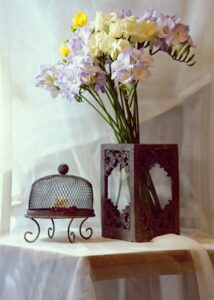
Scented Gardens: Incorporate freesias into scented gardens or sensory gardens to take advantage of their delightful fragrance. Plant them near seating areas, entrances, or pathways where their scent can be fully appreciated.
By utilizing freesias in these various ornamental ways, you can enjoy their beauty and fragrance in multiple aspects of garden design and home decor.
Cultivars of Freesia Flowers
Freesia flowers come in a variety of cultivars, each offering unique colors, forms, and fragrances. Here are some popular freesia cultivars you might consider for your garden or floral arrangements:
Freesia ‘Double Mix’: A mix of double-flowered freesias in various colors, including white, yellow, pink, red, and purple. Highly fragrant with multiple layers of petals, adding a fuller appearance to bouquets and garden displays.
Freesia ‘Single Mix’: A mix of single-flowered freesias in a wide range of vibrant colors. Simpler flower structure compared to doubles, but equally fragrant and colorful.
Freesia ‘Blue Heaven’: Known for its striking blue-violet flowers. Unique color among freesias, with a sweet fragrance and elegant, upward-facing blooms.
Freesia ‘Albatross’: Pure white flowers with a hint of yellow in the throat. Classic and elegant, often used in wedding bouquets and formal arrangements.
Freesia ‘Golden Yellow’: Bright, golden-yellow flowers. Sunny and cheerful, bringing a vibrant pop of color to any garden or bouquet.
Freesia ‘Red Lion’: Bold, red flowers. Striking and dramatic, perfect for making a statement in floral arrangements or garden plantings.
Freesia ‘Pink Passion’: Soft pink flowers with a subtle fragrance. Romantic and delicate, ideal for mixed borders and container gardening.
Freesia ‘Purple Rain’: Deep purple flowers. Rich color and strong fragrance, adding depth to garden palettes and floral designs.
Freesia ‘White Swan’: Pure white flowers with a strong fragrance. Classic and versatile, suitable for all kinds of floral arrangements and garden settings.
Freesia ‘Yellow Queen’: Bright yellow flowers with a prominent scent. Energetic and eye-catching, great for brightening up garden beds and bouquets.
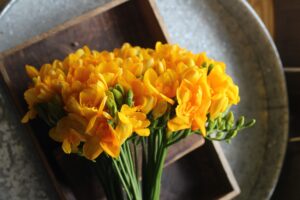



3 comments
you are in reality a good webmaster The website loading velocity is amazing It sort of feels that youre doing any distinctive trick Also The contents are masterwork you have done a fantastic job in this topic
Hi my family member I want to say that this post is awesome nice written and come with approximately all significant infos I would like to peer extra posts like this
Business dicker very informative articles or reviews at this time.